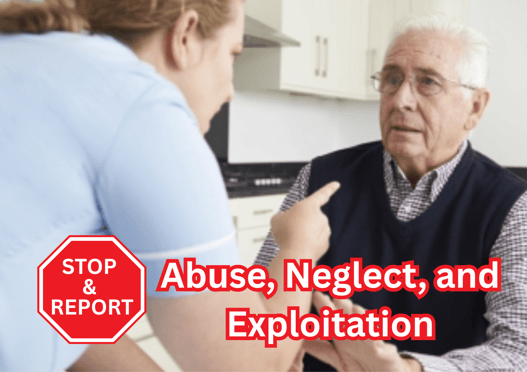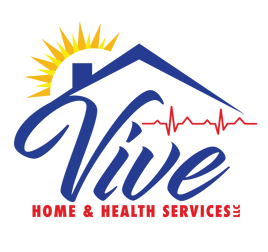Abuse, Neglect, and Exploitation


All people of all ages have the right to be free from Abuse, Neglect, and Exploitation. Every effort should be made to prevent abuse, neglect, and exploitation, and training is the first step to prevention.
Texas law:
Key elements of the Texas laws states that anyone who thinks a child, or person 65 years or older, or an adult with disabilities is being abused, neglected, or exploited must report it to Department of Family and Protective Services (DFPS). A person who reports abuse in good faith is immune from civil or criminal liability. DFPS keeps the name of the person making the report confidential. Anyone who does not report suspected abuse can be held liable for a misdemeanor or felony. Reporting suspected abuse makes it possible for a family to get help.
Physical Abuse: Any knowing, reckless or intentional act or failure to act including unreasonable confinement, corporal punishment, inappropriate or excessive force, or intimidation which caused physical injury, death or emotional harm by a caretaker, family member, paid caretaker or other individual who has an ongoing relationship with the victim.
Examples may include and are not limited to: striking, hitting, pushing, shaking, telling someone else to mistreat someone, rough handling of a person, grabbing a person who is visually impaired and scaring them, etc.
Sexual Abuse: is non-consensual sexual activity.
Examples may include, and are not limited to: any activity (kissing, fondling, stroking, exploitation, etc…) that would be a sexually-oriented offense per Texas Penal Code, Chapters 21, 22 or 43 by a caretaker, family member, paid caretaker or other individual who has an ongoing relationship with the victim.
Emotional/Verbal Abuse: Any act or use of verbal or other communication, including gestures, to threaten violence that makes a reasonable person fearful of imminent physical, mental, or emotional injury.
Examples may include and are not limited to: willful infliction of an act or repeated acts of verbal or other communication, including gestures that is used to curse, vilify, humiliate, degrade or threaten, and that results in significant impairment to her or his physical, mental, or emotional health; substantial physical, mental, or emotional distress as identified by an appropriate medical professional; or be such of such a serious nature that a reasonable person would consider it emotionally harmful by a caretaker, family member, paid caretaker or other individual who has an ongoing relationship with the victim.
Neglect: Failure to provide the protection, food, shelter and/or care necessary to avoid emotional harm or physical injury, or a negligent act or omission that caused or may have caused emotional harm, physical injury or death by a caretaker, family member, paid caretaker or other individual who has an ongoing relationship with the victim.
Examples may include and are not limited to: Not providing adequate nutrition, clothing or health care, not providing a safe environment, not establishing or carrying out an appropriate treatment plan.
Exploitation: The illegal or improper act or process of using, or attempting to use, the resources of the alleged victim, including the alleged victim's social security number or other identifying information for monetary or personal benefit, profit or gain without the informed consent of the alleged victim by a caretaker, family member, paid caretaker, or other individual who has an ongoing relationship with the victim.
Examples may include and are not limited to: Coercing a person to give you their Social Security or SSI checks, knowingly allowing a person receiving services to be unfairly solicited and manipulated by a third-party.
Emergency: Any abuse, neglect or financial exploitation, which, without immediate intervention, would result in the victim being in a state of, or at risk of, immediate and serious physical harm.
Definitions and Examples of
Abuse, Neglect, or Exploitation


Recognizing Abuse, Neglect, and Exploitation




Older people (65 and older), children, and people with disability may show different signs of abuse than others. The following are potential indicators of ANE. This is not an all-inclusive list.
Potential Signs and Symptoms of Abuse:
Physical
· Unexplained signs of injury, such as bruises, black eyes, burns, welts, lacerations, and rope marks.
· Bone fractures, broken bones, and skull fractures.
· Open wounds, cuts, punctures, untreated injuries in various stages of healing, sprains, dislocations, and internal injuries/bleeding.
· Broken eyeglasses/frames, physical signs of being subjected to punishment, and signs of being restrained.
· Injuries that appear to have a pattern such as marks from a hand or belt.
· A person’s report of being hit, slapped, kicked, or mistreated, etc.
Sexual:
· Pregnancy, sexually transmitted infection, anal or vaginal soreness, depression, eating disorders or post-traumatic stress disorder, poor physical health, changes in eating habits (e.g. drastic weight gain or loss), a person’s report of being sexually abused, etc.
Potential Signs and Symptoms of Neglect:
· Dehydration, malnutrition, untreated bed sores, weight loss and poor personal hygiene, unattended or untreated health problems, unsanitary conditions (e.g., dirty, lice on the person, soiled bedding fecal/urine smell), a person’s report of being neglected, etc.
Potential Signs and Symptoms of Exploitation:
· Abrupt changes in a will or other financial documents, unexplained disappearance of funds or valuable possessions, discovery of a person’s signature being forged for financial transactions or for the titles of his/her possessions, a person’s report of financial exploitation, etc.
· Allegations of theft may also be referred to law enforcement.
Potential Behavioral Signs of ANE:
Although many of the behavioral sign(s) can be attributed to other causes, when unexplained consider if they might be a sign of ANE or trauma.
· Appearing restless, uneasy, angry, or showing a lack of interest in once enjoyable activities;
· Displays sexual knowledge or interest in sexual acts inappropriate to his or her experience, or exhibits inappropriately seductive behaviors;
· Sleep difficulties, including an increase in nightmares;
· Is always watchful and “on alert”, as if waiting for something bad to happen;
· Shies away from touch or flinches at sudden movement;
· Makes strong efforts to avoid a specific person or location without an obvious reason;
· Regressive behaviors depending on age, such as thumb-sucking or bed wetting;
· Drug or alcohol abuse, etc.
Risk Factors for ANE
· People with disabilities are four to ten times more likely to be abused than their peers without disabilities;
· People who are socially isolated;
· People who are unable to perform daily tasks independently;
· People with limited mobility or limited physical functioning;
· People who rely on others for support;
· People who are unable to speak or have limited verbal communication;
· People with uncontrolled mental health conditions.
Reporting Requirements
The Texas Abuse Hotline is answered by DFPS Statewide Intake. It is the number to report abuse, neglect, or exploitation of children, the elderly, or people with disabilities in Texas. When you encounter, suspect, or think ANE is occurring, it is your responsibility to report suspected abuse, neglect or exploitation within 24 hours of discovering it.
The Abuse Hotline is 1-800-252-5400, or you can make a non-urgent report at www.TxAbuseHotline.org.
Hearing Impaired or Speech Disabled People who are deaf, hard-of-hearing, or have a speech-disability can report by using a TTY and accessing Relay Texas by dialing 711 or 1-800-735-2989.
Note: Do not use the TxAbuseHotline website to report urgent or emergency situations.
Instead, call the toll-free number if the situation is urgent and needs to be investigated within 24 hours, or call 911 or your local law enforcement agency if an emergency or life-threatening situation exists that must be dealt with immediately. Some examples include and are not limited to: serious injury, immediate need for medical treatment, sexual abuse where the abuser will have access to the victim.
If you ever need this information, you will want to have it readily available. We suggest saving the phone number and the email into your personal phone.
After Reporting
· Preserve and protect any evidence related to the allegation.
· Do what you can to protect the individual (without putting yourself at risk) and ensure their safety.
· Cooperate with the investigator during the investigation including being response to the investigator or intake worker.
· DFPS might give you instructions on how to preserve and protect the evidence, but if not do your best to do so.
· Protecting the individual is the primary focus at this stage but you should not put yourself at risk to protect the individual.
Documentation
To assist in an investigation seeking to protect an individual who is an alleged victim of ANE, complete the following activities, as appropriate:
· Write down what happened regarding the ANE incident, or any suspicions, including verbal conversations, times, and dates.
· Keep copies of any written documents, filed reports of the ANE, and any documents received from oversight agencies.
· Visit a doctor with the victim or go if you are the victim who sustained injuries from suspected ANE, go to the doctor to be able to document those injuries.
· Ask the victim or as a victim, take pictures of any suspected injuries, such as bruises, sustained related to the ANE suspicion or incident.
Prevention Strategies
· Establish appropriate and positive working relationships with people receiving community services, to increase the likelihood that you will pick up on signs and symptoms of ANE.
· Make sure, to the best of your ability, that persons receiving community services have supportive and trustworthy adults, other than their parents and caregivers, who can identify and report ANE.
· Work as a team of care providers to reduce stress on caregivers.
· Teach persons receiving community services the names for their body parts to help them express if inappropriate behavior is occurring.
· As a paid or unpaid caregiver, remember to maintain self-care practices to reduce stress.
Resources
· The Department of Family and Protective Services Report Abuse (DFPS): Report Abuse, Neglect, Exploitation: https://www.dfps.texas.gov/Contact_Us/report_abuse.asp
· Mayo Clinic Health Lifestyle: Stress Management
· VIVE Home and Health Services – College: Caregiver Self-Care https://youtu.be/2dn3J7D45hw
Final Thoughts
To anyone who suspects abuse, neglect, or exploitation, remember that it is essential to speak up. Call local resources or hotlines dedicated to elder services, advocate for the elderly, and educate others about the signs of abuse. By working together, communities can ensure that vulnerable populations are respected, valued, and protected.
Exceptional home care to transform lives today.
COMMITMENT
INNOVATION
(956) 525-7555
© 2025. VIVE Home and Health Services LLC. All rights reserved.
EXCELLENCE
Call us at:
Fax us at:
(956) 525-7071
